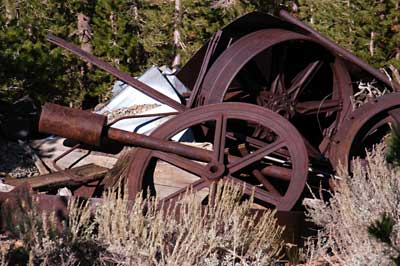 Tucked away in the
Sierra Nevada
Mountains
high above the
Mono
Basin
is an almost completely intact mine and mill.
Legend has it that two prospectors wondered up the mountain and
discovered gold, but one miner was killed in an avalanche before they
could do anything with the claim. The year would have been1890, and the
original file on this claim was listed as
the Mendocino. J. T. Hammond came along in 1909 and recorded a
claim, then along came a man named Jim Simpson who took over in
1910-1911. Simpson rode his
horse with a pack animal from a local store to the mine until someone
named Brand built a road nearby. Simpson
used this road for supplies from Brand’s lodge to his mine.
Tucked away in the
Sierra Nevada
Mountains
high above the
Mono
Basin
is an almost completely intact mine and mill.
Legend has it that two prospectors wondered up the mountain and
discovered gold, but one miner was killed in an avalanche before they
could do anything with the claim. The year would have been1890, and the
original file on this claim was listed as
the Mendocino. J. T. Hammond came along in 1909 and recorded a
claim, then along came a man named Jim Simpson who took over in
1910-1911. Simpson rode his
horse with a pack animal from a local store to the mine until someone
named Brand built a road nearby. Simpson
used this road for supplies from Brand’s lodge to his mine.
Jim Simpson’s family
decided to help him with his gold mine.
His mother, sister, and brother Jack were all involved.
During the summer months the Simpson brothers would work
hard at the mine, but the
harsh snows kept them
off the mountain in the winter.
From 1910-1912, Jim
Simpson filed claims on adjoining lands.
In 1923, his stepfather, M. N. Clark, and Harry Chandler of
Los Angeles
were associated with the mines.
The road that Brand built allowed Bill and Guss Hess to
haul machinery and supplies to the mine with their truck.
Today the name “Guss Hess” remains on a signpost near
the ceiling of one of the many buildings that remain standing at
the mine..
In the 1930’s a
corporation from
Washington
purchased the Simpson mine, and much work took place during this
time, including the construction of a ten stamp mill.
In 1932, Jim
Simpson apparently filed claims on more mines in the area, but by
1939, another company took over everything, including the original
claim. Much of what remains at the site today is from this era and
beyond.
Through a complicated
three-way land swap, the United States Forest Service eventually
acquired this property. Until recently, only a few tried and true
ghost towners or local residents have ventured up the dusty dirt
road, and explored the area. Most refused to talk much about it in
fear that less mindful people
would haul everything away. Today, the
Inyo
National Forest
and the Mono Basin Historical Society have joined hands in efforts
to preserve what remains. Plans are in the making to make this
area safe for general public access to this important part of
California
’s mining history. Buildings
are being locked and
safety hazards removed. Plexiglas
may replace glass windows for viewing the complicated mining
machinery inside these buildings. Interpretive signs may be put up
to help visitors identify what they are seeing.
There’s even talk that a caretaker
will stay at the site during the summer months.

The Mono Basin
Historical Society is spearheading the preservation efforts for
this nearly forgotten mine and mill, but they can’t
do this alone. If enough interest from people who care about
preserving our mining history is not shown, there is a possibility
that these efforts will stall, and this historic site will
fall victim to the harsh winter weather and to the vandals
and souvenir hunters who have discovered it.
We must start a
campaign to save this place for future generations.
Letters must be written to let both the Mono Basin
Historical Society and the
Inyo
National Forest
know that we care, and to
ask them what we can do to help them with their efforts. This is
also the time for us to provide input on what we would like to see
done at the site – perhaps
guided interpretive tours with building access or a museum of
mining equipment and displays with pictures, histories and working
machinery.
Please e-mail us at info@explorehistoricalif.com
or contact Don Banta of the Mono Basin Historical Society
(760-647-6627) or mbhs@qnet.com,
or the
Inyo
National Forest
(760-647-3044), if you would like to
help save this endangered mine and mill.
Volunteers are also needed to help collect
oral or written histories from old timers that actually worked in
this mine.

